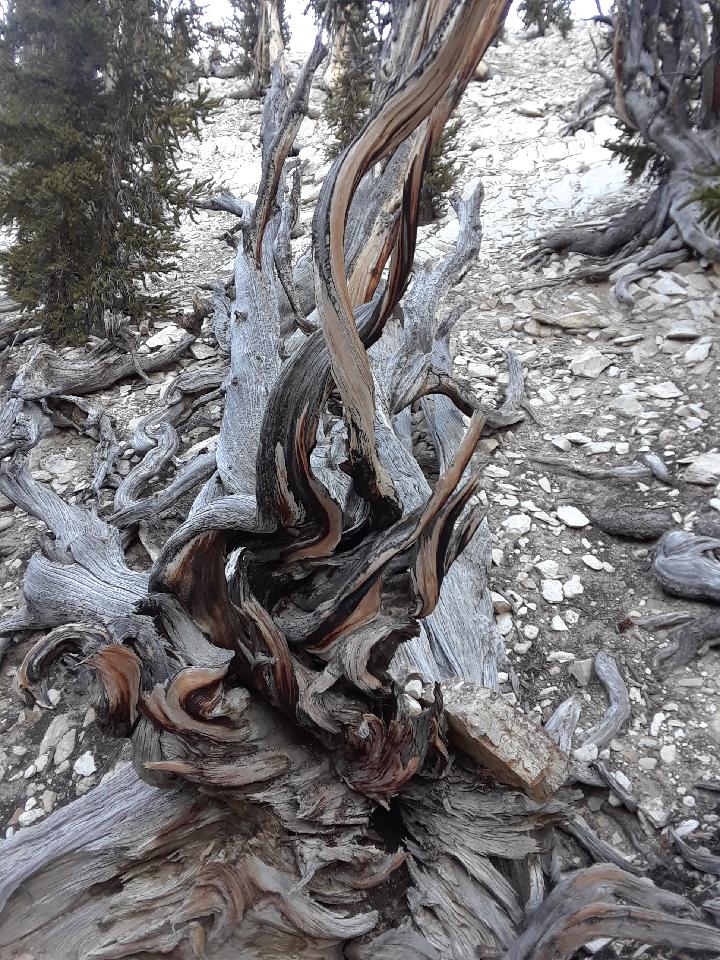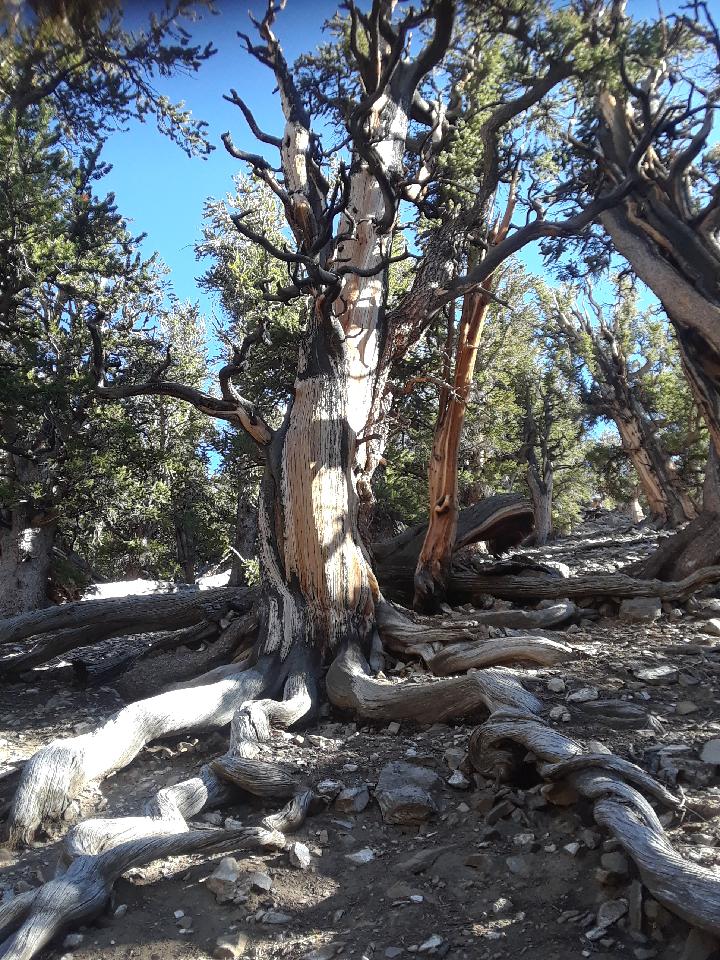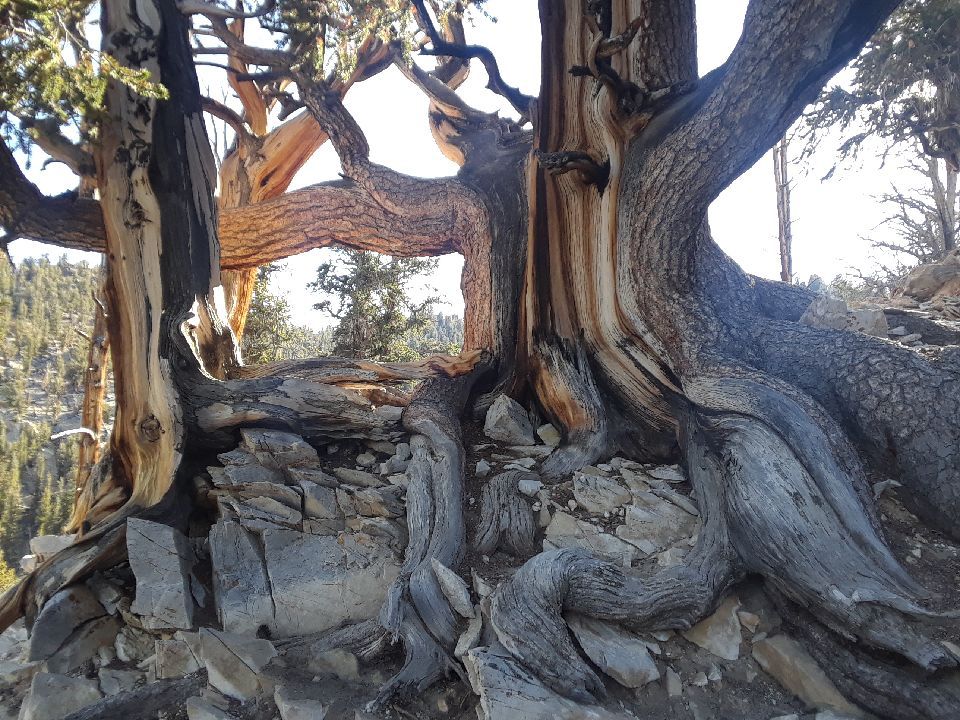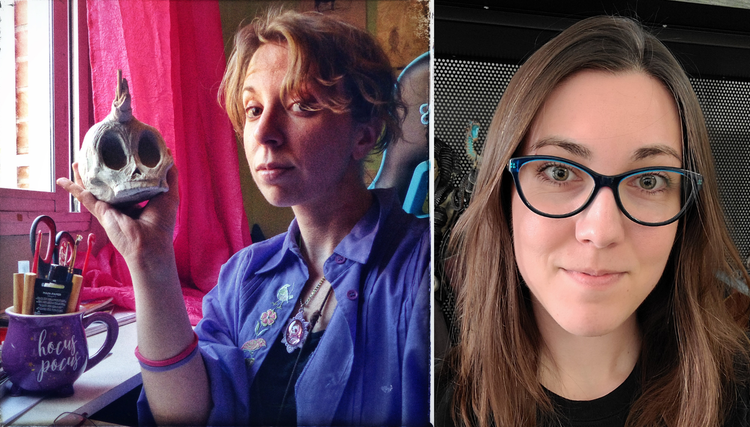The White Mountains

The time I accidentally made a blood sacrifice to the gods of the White Mountains
Ceci n'est pas un arbre.
That is the sign that should rest at the base of every bristlecone pine in the White Mountains. Not a single one of the bristlecones looks like a tree — rather, they all look like they are studiously pretending to be trees, and none of them have consulted each other on how exactly the concept should be executed. They have received a prompt — “tree” — and are each delivering their interpretations, and none of them have gotten it quite right.
Here is the reason I drove into the White Mountains: My friend Matthew told me that there were gods living there. That’s not how he put it, of course. He is a science writer, and he told me about the trees that are thousands of years old, that grow gnarled so tightly that their wood is impenetrable to most boring beetles (and to most interesting beetles, too (I made that joke to Matthew, and he lied and said I am “not funny.”)). He told me about the way none of the trees looked real, how they were all storybook trees from theme parks. And he told me about Methuselah, the bristlecone that is the oldest single tree in the world.
And then he sent me a photograph of Methuselah, and I drove into the white mountains to find it.

My lungs aren't strong. I've always had terrible asthma, and I've always been prescribed lots of drugs for that asthma — especially when I was a child, during the golden age of steroid inhalers. Those inhalers are not particularly kind to developing lungs, and so I have never had an easy time with the whole concept of air. I attacked the notion of Becoming An Athlete as an adult with the full weight of my mighty stubbornness, and so I know how to compensate for my weak lungs with slow, deep, steady, focused breathing.
In the White Mountains, that hard-won skill was rendered worthless. At an elevation of about ten thousand feet, the air is thin, and my brain kept telling me to breathe slower, deeper, steadier. But there just wasn’t enough. I felt the deep alveoli in my lungs open like night-blooming flowers to try to harvest more oxygen from my breaths. It took an hour of hiking before I felt like I wasn’t suffocating.
The trees were impossibly gorgeous. I stopped to lay my hand on one, and the trunk was as warm as skin. The air was cold and getting colder, and the sun was going down and my fingers kept going numb, and I stopped to warm them on tree trunks along the way. Possibly just retained heat from sunlight throughout the day — wood that dense would take a long time to disperse heat. More probably, magic.
(Occam’s razor: if you’re walking among gods and something is strange, think magic, not physics.)
Every tree that I touched looked different, because every tree had been shaped differently by the arid wind that perpetually sweeps around the slow-growing wood. The roots and branches of the bristlecones twisted in impossible gnarled spirals that looked tentacular, kinetic. My brain kept screaming FAKE, FAKE, FAKE — but I tasted the bitterness of Bristlecone sap and I dug my fingers into loam and I watched as a squirrel vanished into the gap between two branches and I had no choice but to accept that this place was real.
I found Methuselah. I won’t tell you where to find him, because I’m sworn to secrecy (and none of the trees pictured here are him), but he looks exactly like every other bristlecone in that he looks like no other tree I’ve ever seen in my life. I whispered a secret to him (I won’t tell you that, either, but it was a good one) and then I hiked back down the mountain. Four hours in all, at ten thousand feet, walking among trees that started growing two thousand years before the beheading of John the Baptist. When I got back to my car, I found a pine needle in my hair that had most likely started growing just before a group of women put pencil to paper to calculate how best to put a man on the moon.
And then I went higher.

Eleven thousand feet is where the Bristlecones stop growing. I hiked to the top of the highest ridge in the White Mountains and looked out across the valley, where I could easily imagine myself as a pile of bones at the base of one of these impossible ancients. I did a little project that involves finding new growth at too-high elevations, an indicator that temperatures are rising at high enough elevations for the trees to spread their footprints upward. I tried to breathe — at eleven thousand feet, it’s all trying-to-breathe for me. I took a picture for my friend Matthew, to show him that I’d gone to a place he’d told me was magic, and I’d seen it for myself.
As I drove back down, from eleven thousand to ten thousand feet of elevation, I saw an enormous shadow on the mountainside up ahead. “Weird,” I thought to myself, “that almost looks like a horse.” But no, it couldn’t be a horse — it was so far away and still looked so enormous, there was just no fucking way that was a horse. A big sign, I decided, something denoting a historic part of the preserve. A small shelter, maybe, for people to rest under if they were making the why-would-you-do-that decision to bike up the mountain.
I got closer, and I thought, wow, I can’t believe I initially thought that was a horse. The altitude must have messed with my head. No horse is that big.
And then I came within a hundred feet of it, and it turned its head to look at me. A horse so big and so black that I thought it was silhouetted until I realized the sun was behind me. Wild as the mountain itself, standing in the sagebrush, and looking right at me with no kind of fear. I stopped the car to look at it, breathing “holyshit holyshit holyshit” until it looked away. I drove away slowly, so as not to kick up gravel, looking in my rearview mirror to make sure it wasn’t following me. Wondering what kind of omen I’d just encountered.

I got out of the car at nine and a half thousand feet of elevation to look at some deadwood I’d passed on the way up. It was all gnarled and spiraled and cool, and Matthew had told me his research indicated it was probably around ten thousand years old. It looked as though it could have fallen just the day before.
As I walked through the deadwood, a flash of red caught my attention. I looked down at my leg, and saw that there was a long, deep cut in my shin. It started stinging as soon as I started looking at it, and I remembered: a stumble at eleven thousand feet, my leg catching on a fallen branch. I realized that I was only now at a high enough oxygen concentration to feel the pain. I wondered how long I’d been bleeding — had I made a blood tribute to the mountain before or after passing that impossible horse? What questions had I been asking the mountain when it extracted the price of an answer?
What promise had I unknowingly made?
I drove down the mountain as the sun sank behind the horizon. I watched the color of the sky change over the valley, and I found myself on the valley floor passing bottlenecked tumbleweeds as the impenetrable desert-darkness took hold. My headlight beams were insufficient. Blood ran down my leg. The song the trees behind me (above me) whispered was one that I knew they’d continue singing long after my bones were between the horse’s teeth.
Ceci n'est pas un arbre.
Ceci est un dieu.






Member discussion